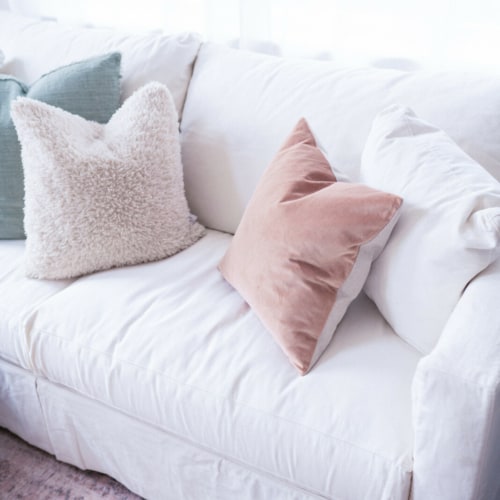The environmental impact of leather is tremendous, with a fifth of greenhouse gases down to animal agriculture and a third of hides making their way to landfill… But do you still want that timeless leather sofa look, while staying in line with your environmental values? I’ve got you covered with these 15 vegan leather sofas!
As a general rule, faux leather is plastic-based, which has its drawbacks from a production and disposal point of view, often involving toxic chemicals and non-biodegradable waste. However, PU is a more eco-friendly leather alternative than PVC. Sustainable vegan leathers made from pineapple, cork, apple and mushrooms are also starting to appear in the furniture industry.

HOT OFF THE PRESS:
I’m personally planning on getting a velvet sofa for our lounge, but having put this list together, I can definitely see the appeal of these vegan leather sofas! So here they are, from least eco-friendly to most sustainable (there are options available in the US, UK and Australia!):

(Note: this blog post contains affiliate links to products I genuinely like. They are all vegan-friendly to the best of my knowledge. If you click a button or a link and make a purchase, I may earn a commission at no cost to you. Thank you for supporting my work!)
PVC sofas (and mystery vegan leather ones!)
Many vegan leather sofas will be made from PVC (polyvinyl chloride), which is unfortunately the most environmentally-damaging plastic, as it releases chlorine-based chemicals during its production, use and disposal. This is where you will find more affordable sofas, and if you’re pinching pennies, it may be a trade-off you’re willing to make.
I’ve included in this category the faux leather sofas where the product description doesn’t specify the exact material. They could be made with a different vegan leather, but I suspect they might be PVC.
(Pssst make sure you open my list of 11 vegan-friendly sofas at IKEA in another tab too!)
This DFS sofa was awarded “Best Leather Free Sofa Range” by Peta:

Albany Sofa in Distressed Vegan Leather
As a side note, while updating this list, I’ve found lots of sofas labelled as “vegan leather sofas”, which then have duck down feathers in… So make sure to read what else is in your sofa if this is something you want to avoid!
PU vegan leather sofas
PU (polyurethane) is better than PVC plastic: the chemicals are less toxic for the environment, but it can have a shorter shelf-life. By the way, the conventional tanning process of real leather also includes toxic chemicals (“vegetable-tanned” leather is less toxic).
Neither of the plastic-based leather alternatives are biodegradable. But then again, the leather we use is so treated with chemicals that it also doesn’t biodegrade as well as we could expect from a “natural material”.
Here’s what Corinne Segura of My Chemical Free House has to say about PU vegan leather sofas:
I like PU because it doesn’t contain plasticizers, PFAS, or other stain guard chemicals, it’s low odor – and even that will pass soon. It also is quite a good block of VOCs or semi-VOCs that could be coming from inside the couch.
I love the subtle glam look of the white sofa!
Plant-based sofas
I’ve grouped the more natural materials in this “plant-based sofa” category. These include exciting innovations using cork, apple skins, mushrooms… Piñatex for example is made from pineapple leaves, a by-product of the pineapple industry that would otherwise go to waste.
These materials are starting to make an appearance in fashion and accessories, but it is still very much the early days for them being used in making furniture. To the point that experimenting with them makes headlines.
So I’ve only got a couple sofas in this category available for purchase… Please DM me if you know of any more and I’ll add them to the list! That way hopefully in the coming years, I’ll be able to feature only eco-friendly and safe vegan sofas.
Cork sofa, in Jenolan black (unavailable at the time of writing, but maybe bookmark it and check back later?)
Other vegan leather sofa options
I haven’t covered lab-grown leather sofas yet, as to the best of my knowledge they’re not available commercially yet, but that could be an option in the coming years, as there’s currently quite a bit of development in the lab-grown meat world. So watch this space!
As always, the most sustainable option is not buying anything at all! Second best is buying something second-hand, so if you’re on a budget, do check out Facebook Marketplace and Craigslist to give a second life to a sofa. But hopefully the options above were helpful if you’re looking for a vegan leather sofa and feeling a bit stuck!
This post was all about vegan leather sofas
You may also like:
- Looking for a vegan sofa bed? Here’s one for every style!
- 11 stylish and vegan-ish IKEA sofas
- Where to find vegan furniture in the UK (and beyond!)
This post was originally published in October 2022. It has been reviewed it and updated in February 2024.

















![Only a month late... Here are our Valentine's Day photos! 👩🏼❤️💋👨🏻😅
We've been on a bit of a Caribbean kick (say that 10 times!) since watching the One Love film about Bob Marley on Valentine's Day + @gazoakley's adventures in Jamaica on the YouTubezz. 🇯🇲
So far we've eaten at @turtlebayuk [apologies for the blurry photos, I took them before getting my new @fairphone!] and ordered from Pappy's Afro Caribbean Takeaway (don't think they're on Instagram)... Next step is to make it at home; any recipe recommendations? 😘
#PlantBased #JamaicanFood #CaribbeanFood #OneLove](https://jessicagoodenough.com/wp-content/plugins/instagram-feed/img/placeholder.png)